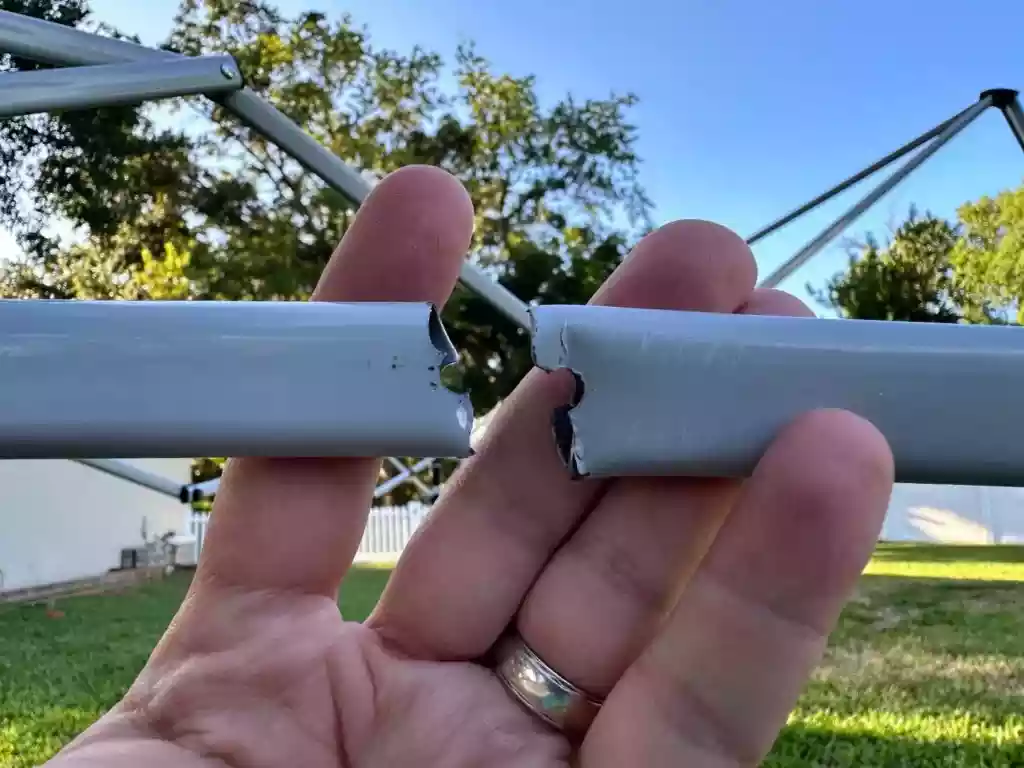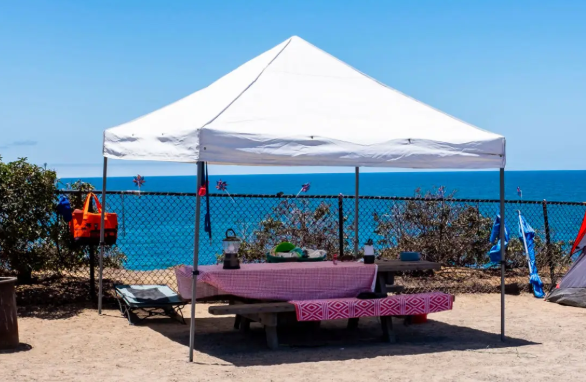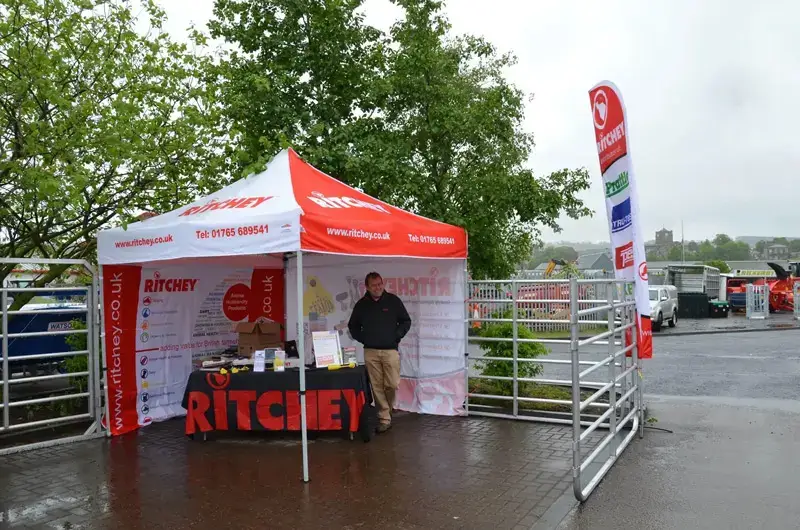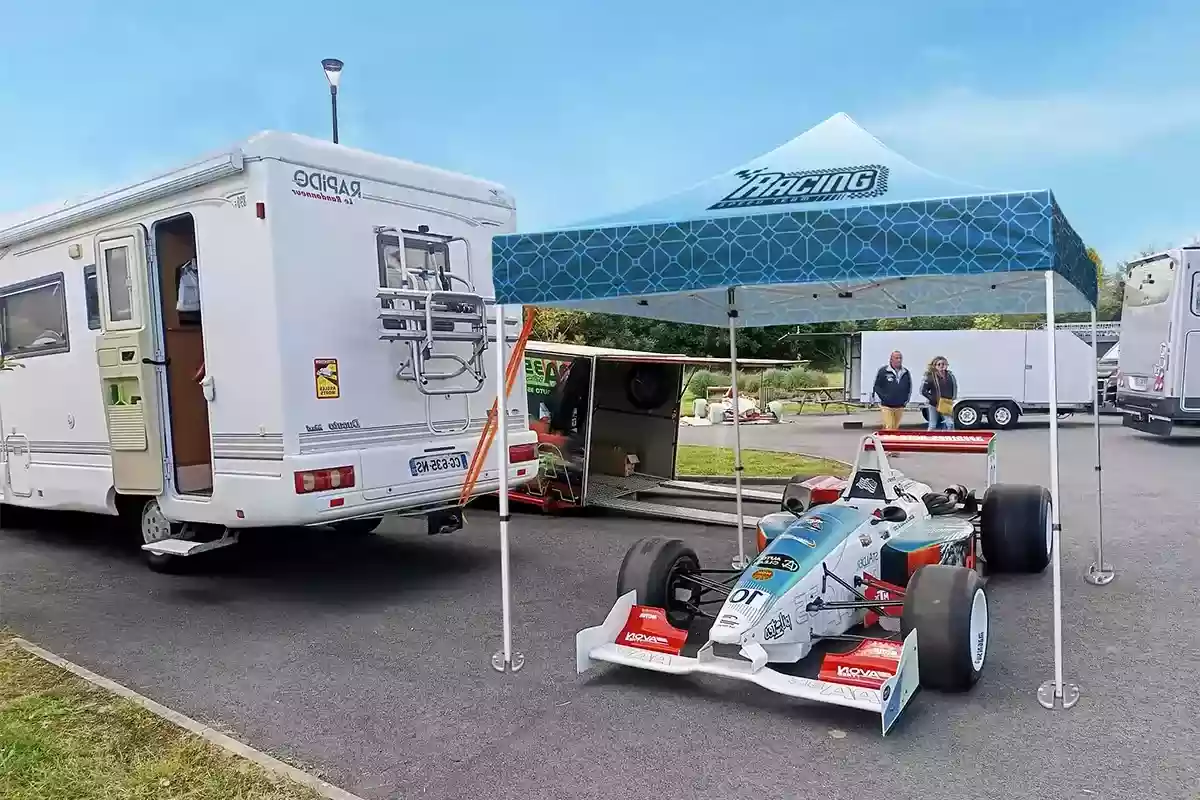
A canopy tent is a portable shelter, commonly used for various outdoor activities. However, winds can affect its stability. If your pop up canopy blows away at a trade show, it can negatively impact your brand and pose a safety hazard. To ensure your tent stays securely anchored to the ground, some additional methods are needed. Here, we’ll share some practical tips on how to secure a canopy in the wind.
Importance of Securing a Canopy

Anchoring your canopy tent is necessary on windy days. In heavy winds, an unsecured canopy may cause personal injury, property damage and disrupt activities. Additionally, high winds may also damage the tent, such as tearing the fabric or bending the poles, shortening its life. A sturdy pop-up canopy protects your business and creates a positive experience for attendees. By anchoring it with straps, ground stakes, or weighted bags, you can improve the wind resistance of the canopies, reducing the risk of it collapsing or being blown away.
How to Secure a Canopy in the Wind: 5 Effective Methods
Securing your pop-up canopy tent is a critical step in ensuring the stability, safety, and success of your outdoor event. Let’s explore some practical methods for anchoring this outdoor shelter in high winds.
Heavy-duty weights
Heavy-duty weight plates are helpful to hold down canopy. They are made of sturdy materials such as steel or concrete, commonly used to weigh down canopies on the ground. You can install them directly on the tent legs or elsewhere to add weight to the tent poles. These plates can withstand outdoor weather conditions and work for a long time. They are a popular choice for securing a canopy tent due to easy transportation and installation.
Water weights
Water-filled containers can serve as excellent temporary weights. Tying water weights to the tent legs can anchor tents on the ground. They can be filled on-site and emptied after use. The empty water barrels are convenient to transport. When installing water weights, you should place them on a flat surface and seal them well to prevent them from breaking and leaking.
Sandbags

Sandbags for tents are another practical option for securing your outdoor pop up canopy. By filling sandbags and fastening them to the tent legs to create a sturdy base, the wind resistance of the tent can be increased. They are convenient to store and transport, suitable for various surfaces such as beaches, grass, and concrete, especially on beaches, where sand is readily available.
Stakes
Tent stakes are well-suited for anchoring tents to grass or other soft ground. Attaching them to tent legs or frame with guy ropes, then inserting them into the ground at a diagonal 45-degree angle, the tent can be held securely in place. Stakes are usually made of metal materials, which are easy to carry and relatively cheap. They are a popular choice for outdoor activities and suitable for all weather conditions. Notably, stakes are only to be used on grass or dirt surfaces.
Straps
Securing straps can be used for all pop-up canopies. You can use straps to directly attach a canopy to solid and stable anchor points such as trees or poles, or use them to tie heavy weights to the tent poles. In adverse weather conditions, these two methods can be used simultaneously to provide double insurance for your tent and reduce movement during gusty winds. Many tents come with tie down straps, which can be adjusted and securely fastened.
The above methods can be used individually or in combination. For example, you can use both ground stakes and weights to hold down canopy. This combination provides your tent with multiple protections against strong winds, achieving optimal safety.
Preparing Your Tent for Windy Day
To hold down your canopy in heavy winds, in addition to knowing how to secure a canopy in the wind, you also need to know some other factors that affect wind resistance of a canopy.
Select the Right Tent
The wind resistance of a canopy tent mostly depends on its material, design, and model. Generally speaking, a wind resistant canopy can withstand wind speeds of 30 to 40 MPH. When choosing the perfect canopy tent for a windy day, it is better to pick durable, weather-resistant fabric and a sturdy aluminum frame. Besides, select a canopy with a curved or sloping design that allows wind to pass through, reducing the risk of tip-overs. If you want to use it in all high-wind situations, you’d better choose a heavy duty wind-resistant canopy.
Check Weather Forecasts
Before you go on an outdoor activity, you should pay attention to the weather forecast for the area where you will be active that day. This can help you know the wind speeds on that day and secure your tent accordingly. If heavy winds or extreme weather are predicted, you’d better prepare reinforcement tools in advance to secure canopy as much as possible.
Choose a Sheltered Location
When setting up your canopy, try to find flat, firm ground and avoid uneven ground such as hills or potholes. In addition, if it is a windy day, try to find an area where trees or buildings provide shelter from the wind.
Set Up Your Tent Correctly
An unstable tent is more likely to be blown away by the wind, so you must follow the steps to set up your tent properly. Before assembling your tent, please clear the ground of gravel, rocks, or other obstacles that may hinder the setting process or damage the tent. Be sure to read the instructions carefully and follow professional steps to set up.
Maintain Your Securing Equipment
You need to keep the anchor system clean and dry to prevent rust or damage. Inspect the securing equipment regularly for wear, damage, or corrosion. If you find any obvious wear or damage, replace it immediately to maintain the security of your pop up canopy.
Opt for Professional Accessories
Consider purchasing professional tools, although some tools can be self-made. Professional-grade products are rigorously tested for safety. Westshade can not only provide you with excellent canopy tents, but offer specialized securing tools. Our products are specially designed and manufactured. For example, sandbags are outfitted with sturdy PVC layers, weight plates are made of heavy-duty steel coated with silver, and water weights are made of heavy-duty HDPE and commercial-grade Velcro straps. These professional tools can withstand outdoor weather conditions for a long service life.
FAQs
Can a canopy withstand wind?
Canopies vary in their ability to withstand wind, depending on factors like their materials, design, and how they are anchored. Most canopies on the market are somewhat wind-resistant. Moreover, some designed to be wind-resistant, with features like heavy duty frames, reinforced truss bars, and robust anchoring systems. However, even the most strong canopy tents have limits. Extremely strong winds can potentially damage or topple them. It’s not recommended to use canopy tents in severe windy conditions.
What is the best canopy for wind?
Best canopies for wind are usually those that come with heavy-duty frames and wind-resistant fabric. They are durable, sturdy, and weather-proof. Besides, they feature multiple height adjustment options, allowing you to adapt to weather changes. Meanwhile, they have reinforced frame structures and securing accessories to remain stable in high winds.
How to anchor a canopy on grass?
Grass surfaces are generally easier to secure. Ground stakes are a popular choice for grassy areas, as they can be driven into the ground to provide excellent stability. Make sure to fully insert the stakes and angle them away from the tent for maximum hold. If the ground is particularly soft, you can reinforce the stakes with additional support, such as tying them to nearby trees or using sandbags.
Conclusion
Securing the canopy in the wind is necessary for your outdoor events. You can use ropes, ground stakes, weight bags, and other securing tools to increase the stability and wind resistance of your canopy tent. Besides, choose professional tents and tools to ensure safety. You also need to be aware of the weather forecast and ground conditions when conducting activities, avoiding outdoor activities in extreme weather.
As a professional canopy retailer in the US, Westshade provides an array of pop up canopy tents and various accessories. Our canopy fabrics can withstand 35-45 mph winds.
For those who want the best canopy for wind and rain, our custom canopy tent is the perfect choice. Not only can you choose better quality fabrics, but you can customize the printing to promote your brand through personalized graphics. Buying a canopy tent now will give you a free wheeled protective cover, straps, sandbags, and steel stakes to help you better store and secure your canopy in the wind. Check Westshade for more information.







